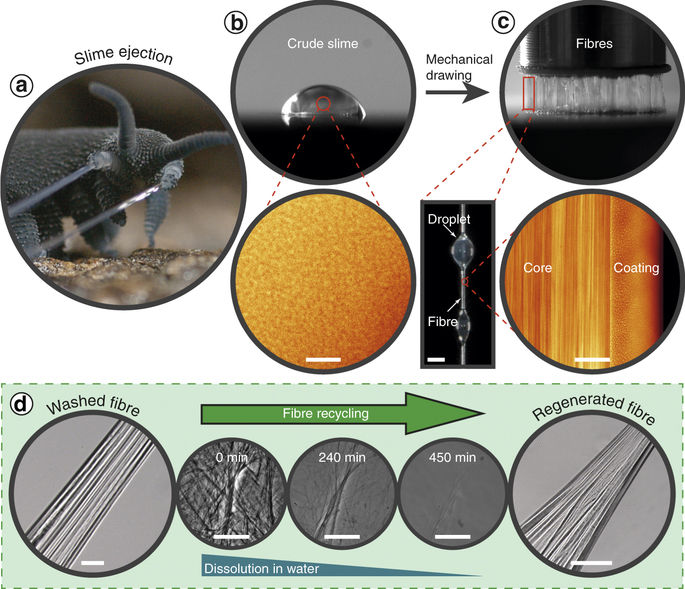当前位置:
X-MOL 学术
›
Nat. Commun.
›
论文详情
Our official English website, www.x-mol.net, welcomes your
feedback! (Note: you will need to create a separate account there.)
Mechanoresponsive lipid-protein nanoglobules facilitate reversible fibre formation in velvet worm slime.
Nature Communications ( IF 14.7 ) Pub Date : 2017-10-17 , DOI: 10.1038/s41467-017-01142-x Alexander Baer , Stephan Schmidt , Sebastian Haensch , Michaela Eder , Georg Mayer , Matthew J. Harrington
Nature Communications ( IF 14.7 ) Pub Date : 2017-10-17 , DOI: 10.1038/s41467-017-01142-x Alexander Baer , Stephan Schmidt , Sebastian Haensch , Michaela Eder , Georg Mayer , Matthew J. Harrington

|
Velvet worms eject a fluid capture slime that can be mechanically drawn into stiff biopolymeric fibres. Remarkably, these fibres can be dissolved by extended exposure to water, and new regenerated fibres can be drawn from the dissolved fibre solution-indicating a fully recyclable process. Here, we perform a multiscale structural and compositional investigation of this reversible fabrication process with the velvet worm Euperipatoides rowelli, revealing that biopolymeric fibre assembly is facilitated via mono-disperse lipid-protein nanoglobules. Shear forces cause nanoglobules to self-assemble into nano- and microfibrils, which can be drawn into macroscopic fibres with a protein-enriched core and lipid-rich coating. Fibre dissolution in water leads to re-formation of nanoglobules, suggesting that this dynamic supramolecular assembly of mechanoresponsive protein-building blocks is mediated by reversible non-covalent interactions. These findings offer important mechanistic insights into the role of mechanochemical processes in bio-fibre formation, providing potential avenues for sustainable material fabrication processes.Velvet worms expel a fluid slime that, under shear force, forms stiff fibres that can be dissolved and then regenerated. Here, the authors reveal that the recyclability of these biopolymers relies on mechanoresponsive lipid-protein nanoglobules in the slime that reversibly self-assemble into fibrils.
中文翻译:

机械响应性脂质蛋白纳米球促进天鹅绒蠕虫泥中可逆纤维的形成。
天鹅绒蠕虫会喷射出一种液体捕获粘液,该粘液可以机械地拉成坚硬的生物聚合物纤维。值得注意的是,这些纤维可以通过长时间暴露在水中而溶解,并且可以从溶解的纤维溶液中提取出新的再生纤维,这表明该过程是完全可回收的。在这里,我们用天鹅绒蠕虫Euperipatoides rowelli对这种可逆的制造过程进行了多尺度的结构和成分研究,揭示了生物聚合物纤维的组装是通过单分散的脂质蛋白纳米球来实现的。剪切力使纳米球自组装成纳米纤维和微纤维,可以将其拉成具有富含蛋白质核心和富含脂质涂层的宏观纤维。纤维在水中的溶解导致纳米球的重新形成,提示这种机械反应性蛋白质构建模块的动态超分子组装是由可逆的非共价相互作用介导的。这些发现为机械化学过程在生物纤维形成中的作用提供了重要的机械学见解,为可持续的材料制造过程提供了潜在的途径。天鹅绒蠕虫排出一种液体粘液,该粘液在剪切力作用下形成可以溶解然后再生的硬质纤维。在这里,作者揭示了这些生物聚合物的可回收性依赖于粘液中机械反应性脂质蛋白纳米球,该粘液可逆地自组装为原纤维。天鹅绒蠕虫排出一种液体粘液,该粘液在剪切力作用下形成坚硬的纤维,可以溶解然后再生。在这里,作者揭示了这些生物聚合物的可回收性依赖于粘液中机械反应性脂质蛋白纳米球,该粘液可逆地自组装为原纤维。天鹅绒蠕虫排出一种液体粘液,该粘液在剪切力作用下形成可以溶解然后再生的硬质纤维。在这里,作者揭示了这些生物聚合物的可回收性依赖于粘液中的机械响应性脂质蛋白纳米球,可逆性自组装为原纤维。
更新日期:2017-10-17
中文翻译:

机械响应性脂质蛋白纳米球促进天鹅绒蠕虫泥中可逆纤维的形成。
天鹅绒蠕虫会喷射出一种液体捕获粘液,该粘液可以机械地拉成坚硬的生物聚合物纤维。值得注意的是,这些纤维可以通过长时间暴露在水中而溶解,并且可以从溶解的纤维溶液中提取出新的再生纤维,这表明该过程是完全可回收的。在这里,我们用天鹅绒蠕虫Euperipatoides rowelli对这种可逆的制造过程进行了多尺度的结构和成分研究,揭示了生物聚合物纤维的组装是通过单分散的脂质蛋白纳米球来实现的。剪切力使纳米球自组装成纳米纤维和微纤维,可以将其拉成具有富含蛋白质核心和富含脂质涂层的宏观纤维。纤维在水中的溶解导致纳米球的重新形成,提示这种机械反应性蛋白质构建模块的动态超分子组装是由可逆的非共价相互作用介导的。这些发现为机械化学过程在生物纤维形成中的作用提供了重要的机械学见解,为可持续的材料制造过程提供了潜在的途径。天鹅绒蠕虫排出一种液体粘液,该粘液在剪切力作用下形成可以溶解然后再生的硬质纤维。在这里,作者揭示了这些生物聚合物的可回收性依赖于粘液中机械反应性脂质蛋白纳米球,该粘液可逆地自组装为原纤维。天鹅绒蠕虫排出一种液体粘液,该粘液在剪切力作用下形成坚硬的纤维,可以溶解然后再生。在这里,作者揭示了这些生物聚合物的可回收性依赖于粘液中机械反应性脂质蛋白纳米球,该粘液可逆地自组装为原纤维。天鹅绒蠕虫排出一种液体粘液,该粘液在剪切力作用下形成可以溶解然后再生的硬质纤维。在这里,作者揭示了这些生物聚合物的可回收性依赖于粘液中的机械响应性脂质蛋白纳米球,可逆性自组装为原纤维。

















































 京公网安备 11010802027423号
京公网安备 11010802027423号